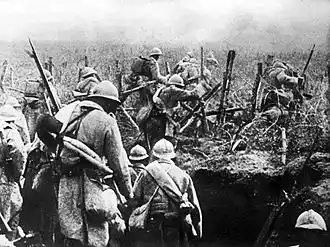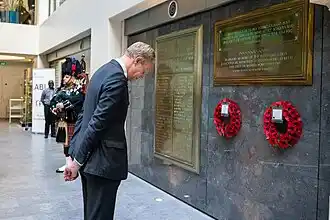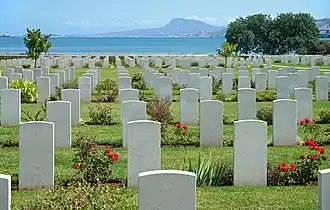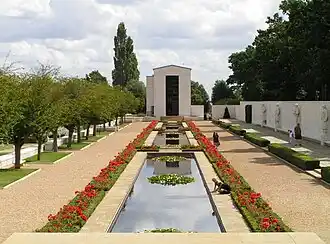
Death and burial practices during World War I & II during World War II were shaped by the immense scale of the conflicts. National governments, the military and designated authorities had to manage and document mass casualties as effectively as possible, taking into account the practical realities of the battlefield and the available facilities.
As a result, and despite the best efforts of these entities, the exact circumstances of deaths as well as the identity and whereabouts of millions of individuals remains unknown to this day. There was also considerable variation in the way different countries managed, documented and buried their war dead. All these factors can pose significant challenges to family historians seeking information about ancestors who died during, or as a result of, these conflicts.
Note: In the descriptions below references to "soldiers" are a shorthand way to refer to combatant and non-combatant personnel from all branches of the military.
Research your ancestors on MyHeritage
The scale of military deaths during the two world warsThe scale of military deaths during the two world wars

The death tolls as a result of World War I and World War II were enormous. Millions of soldiers and civilians were killed. The deaths were not just directly due to combat, but other war-related causes such disease and famine. In the case of WW II the civilian toll was further exacerbated by deliberate action aimed at the destruction of entire populations.
The estimated total deaths during WW I are in the region 15-22 million, made up of about 9-11 million soldiers and 6-7 million civilians.
For WW II total deaths are estimated at between 70-85 million, including around 21-25 million soldiers and 50-55 million civilians[1].
The management of military deaths during the two world warsThe management of military deaths during the two world wars
Compared to earlier conflicts, WWI caused unprecedented levels of death, both in scale and geographic spread. Emerging new technologies, in both communications and combat casualty care, fundamentally changed the nature and challenge of handling and documenting military deaths across all combatant countries:
- In many countries Graves Registration Units were created and made responsible for recording and tracking war dead[2].
- Military casualty lists were published in newspapers, giving families some early information about the status of their loved ones while awaiting more official advice[3].
- Due to the chaotic nature of trench warfare, many soldiers were buried where they fell in temporary graves. These were often designated with hastily constructed markers, such as simple wooden crosses or plaques.

Battlefield conditions of WWI created immense identification challenges. Even though the issue of identification ("dog") tags to military personnel had become increasingly common since the late 19th many were still buried as "unknown". New weapons, such as high powered artillery, caused immense physical damage to soldiers. Logistical problems in recovering bodies in harsh conditions and inadequate mortuary facilities were other complicating factors with identification[4].
- State-sponsored commemoration of the military dead became more common and formalised. National war memorials, including tombs to recognise the "unknown soldier", were built and rituals such as the "Armistice Day" 1 or 2 minute's silence at 11am on 11 November each year were introduced[5].
In WWII the handling and documentation of military deaths built on the experience of the WW I as well as further advances in communication technology, transportation facilities and medical/mortuary services:
- Progress in medical treatment, such as better resuscitation, blood transfusion, anaesthetics, antiseptics and the ability to set compound fractures reduced battlefield deaths from shock and infection[6].
- Graves Registration Units became more organised and better equipped. The use of detailed records and maps improved the accuracy of burial site documentation.
- Bodies of military personnel initially buried in temporary graves were more regularly exhumed at a later date, to be re-buried in permanent cemeteries, at home or abroad.
- The use of dental records and fingerprints improved the accuracy of identifying fallen soldiers.
- Some countries offered the option of repatriation of bodies of soldiers to their home country.
- Recognising and legitimising the emotional toll of battlefield casualties psychological support was more systematically provided to bereaved families as well as to surviving military personnel[7].
Practices in different combatant countriesPractices in different combatant countries

Especially during WW I there were no standardised methods for documenting military casualties across different countries. Nations developed their own systems and methodologies, leading to significant variations in the accuracy and comprehensiveness of casualty records:
- The United States documented military casualties through official government reports published from the 1920s onwards. These reports included detailed statistics on combat-related deaths, as well as those caused by disease and accidents. The U.S. War Department compiled casualty lists that were later amended for accuracy, contributing to the understanding of total military losses[8].
- The United Kingdom, including its colonies as well as counties of the British Empire such as Australia, Canada, India and New Zealand, also maintained casualty records through official reports. The Commonwealth War Graves Commission (CWGC) was established in 1917 to document and commemorate military deaths and well as manage military cemeteries world-wide. Over time the CWGC progressively revised earlier casualty statistics to include a broader range of military deaths. This ensured that non-combat military deaths were accounted for more accurately than before.
- France produced detailed casualty statistics, which included combat-related deaths and those from other causes. Unlike some other countries the French approach to documentation included both figures taken from official military records and estimates based on statistical compilations[9].
- The Axis powers of Germany and Austria-Hungary (WW I) and Germany, Italy and Japan (WW II) also documented casualties suffered in the two wars. But the domestic political and economic chaos they experienced in the aftermath of their loss made accurate reporting especially challenging. While Russia was a victorious nation, revolutionary turmoil in the aftermath of WW I and the immense loss of life and property after WW II caused many of the same problems. It is generally accepted that in WW II Russia suffered the most military deaths of any single country, by a large margin[10].
Notable military burial sitesNotable military burial sites

There are numerous military burial sites throughout the world. The CWGC alone manages over 23,000 separate burial sites and 200 memorials[11]. Among the most notable sites:
- Arlington National Cemetery (Virginia, USA) is the final resting place for over 400,000 American military personnel.
- Tyne Cot Cemetery (Belgium) is the largest British Commonwealth war cemetery in the world. It commemorates those who died at Ypres during WW I.
- Normandy American Cemetery (France) honors American soldiers who died in Europe during WW II.
- Rookwood Cemetery (Sydney, Australia) includes a section dedicated to military graves, commemorating Australian soldiers from various conflicts.
- Luxembourg American Cemetery (Luxembourg) is the final resting place of General George S. Patton and over 5,000 American soldiers who fought in the 1944 Battle of the Bulge.
- National Memorial Cemetery of the Pacific (Hawaii) is the the burial site for many who died in the Pacific theatre during WW II.
- Bayeux War Cemetery (France) is the largest British military cemetery in France for those who died during the 1944 Normandy Invasion.
- La Cambe German War Cemetery (France) is a major burial place for German soldiers in WW II.
- Langemark Cemetery (Flanders, Belgium) is the final resting place for around 25,000 German soldiers from WW I.
- Ysselsteyn German War Cemetery (Netherlands) is the largest German war cemetery in the world, with over 31,000 graves from both WWI and WWII.
- Federal Military Memorial Cemetery (Mytishchi, near Moscow) serves as a national military cemetery for Russia, honouring soldiers and notable figures from various conflicts.
- The Military Memorial of Monte Grappa (between the provinces of Treviso and Vicenza, Italy) is the largest Italian military ossuary from WWI. It contains the remains of almost 23,000 soldiers, both Austro-Hungarian and Italian, only a small proportion of whom have been positively identified.
- Chidorigafuchi National Cemetery (Tokyo) is a national Japanese cemetery and memorial for about 352,000 unidentified WWII war dead.
How to research military deaths & burialsHow to research military deaths & burials
Here are some options and suggested resources to help you get started in researching military deaths & burials from WW I & WW II:
Online Databases and Archives
- Commonwealth War Graves Commission (CWGC) maintains records of British Commonwealth soldiers who died during the war. Online you can search for individual soldiers, cemeteries, and memorials.
- Great War is an online resource that provides information on various war grave agencies and other records for war dead from WW I. It includes guidance on how to find records for British, Commonwealth and other nations' military dead.
- The U.S. Department of Veterans Affairs has burial records of veterans and their family members from VA National Cemeteries, state veterans cemeteries, and other veterans cemeteries around the country.
- American Battle Monuments Commission provides a searchable database of burial sites and memorials for U.S. military personal.
- Military History Forums, for example Axis&Allies.org, are devoted to specific campaigns or military units. They can be valuable for sharing information and finding resources about soldiers who died.
National Archives
- National Archives (UK) holds extensive records related to the two world wars, including service records, war diaries, and burial records.
- National Archives (USA) offers similar online resources for American soldiers, including their service records and burial information where this is available.
- Similar National Archives exist in most other countries, for example France, which lost soldiers in the two world wars.
Local Resources
- Libraries, Historical Societies and War Memorials, located in either district of the home country where soldiers were recruited or near the site of the battle in which they perished often have records, photographs, other items as well as personal accounts related to their deaths.
Military Records
- Individual Service Records can provide detailed information about a soldier's service, including the circumstances of their death and where they were buried.
- Campaign records of the unit of the military in which an individual served can provide a broader context for soldiers killed in action and may mention individuals by name. Such records are usually made available through National Archives or War Memorials.
- Medal or Honour Rolls can sometimes include information about an individual soldier's death and/or burial.
Books and Publications
- Many books on the world wars provide detailed accounts of battles, including information on deaths, burials and cemeteries.
- Military History Journals have articles about specific aspects of WW I & WW II, including battlefield deaths and burial practices.
Explore more about death and burial practices during World Wars I & IIExplore more about death and burial practices during World Wars I & II
MyHeritage's offers a wealth of information to assist you in your search for details of death and burial practices or the fate of individual soldiers. In each case you can search by country or other specific parameters to narrow the collections down to information directly relevant to ancestors of interest:
- MyHeritage's online databases include almost 88 million records across over 675 collections related to military service. Many of these cover casualty records, details of Honour Rolls and Military Awards, campaign histories, and other important information relating to soldiers who died in, or as a result of, WW I & WW II.
- MyHeritage also offers a further 113 collections with over 2.5 historical records from newspapers all over the world. As noted above military casualty lists were often published in contemporary newspapers. As well these newspapers typically included reports of major battles as well as stories of the fate or achievements of individual soldiers.
- The MyHeritage Kowledge base includes a number of resources to assist your search including webinars on Military Records: Search by Name on MyHeritageand Ask The Expert – Military Records on MyHeritage
- Legacy FamilyTree Webinars library includes another 70 different webinars on all aspects of military records.
References
- ↑ The National Archives. (2021, March 29). Deaths in the first and Second world wars.
- ↑ Wikimedia Foundation. (2024, August 6). Mortuary affairs. Wikipedia.
- ↑ Encyclopædia Britannica, inc. (2024, August 16). Killed, wounded, and missing.
- ↑ “A sacred duty”: Locating and creating Australian graves in the ... (n.d.-a).
- ↑ Two-Minute silence: Remembrance: Royal british legion. The Royal British Legion. (n.d.).
- ↑ Tibbitts, C. C. (n.d.). Casualties of War. Australian War Memorial.
- ↑ A quick guide to medical services in the Second World War. Imperial War Museums. (n.d.).
- ↑ World War II casualty lists. (n.d.-c).
- ↑ Victor Gay and others (2023, September 23). Morts pour la France: A database of French fatalities of the Great War. Morts Pour la France: A database of French fatalities of the Great War.
- ↑ Wikimedia Foundation. (2024b, August 13). World War II casualties. Wikipedia.
- ↑ The Great War On This Day. (2023, August 12). Commonwealth War Graves Commission.

